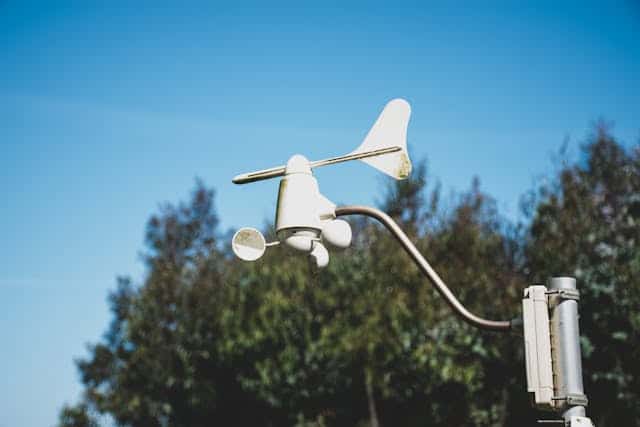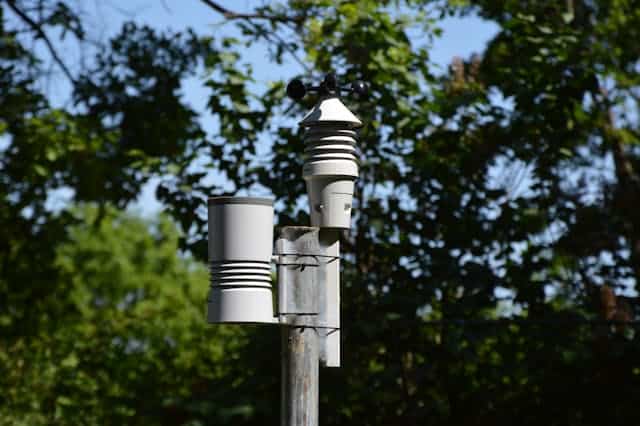Anemometers are nifty gadgets used to measure wind speed. You might have seen them spinning atop weather stations or even on your phone’s weather app.
But have you ever wondered if anemometers are used for hurricanes? In this blog post, we’ll explore the role of anemometers in understanding hurricanes, hop into the science behind measuring hurricane winds, and explore how these devices contribute to our understanding of these powerful storms.
Are anemometers used for hurricanes?
Anemometers are extensively used for measuring wind speeds during hurricanes. These devices provide crucial data for understanding the intensity and behavior of hurricanes, aiding in forecasting and disaster preparedness efforts.
Anemometers are deployed on various platforms, including hurricane-hunting aircraft and weather stations, to gather real-time wind speed measurements within these powerful storms.
are deployed on various platforms, including hurricane-hunting aircraft and weather stations, to gather real-time wind speed measurements within these powerful storms.
Understanding Hurricanes:
Before we dive into the specifics of anemometers, let’s grasp the basics of hurricanes.
Hurricanes, also known as tropical cyclones or typhoons depending on their location, are powerful and complex weather phenomena driven by the Earth’s rotation and the ocean’s warmth.
These massive storms typically form over warm ocean waters near the equator, where the sea surface temperatures exceed 26.5°C (80°F), providing the energy needed for their development.
As warm, moist air rises from the ocean’s surface, it cools and condenses, forming towering thunderstorms and an area of low pressure at the storm’s center, known as the eye.
Surrounding the eye is the eyewall, where the strongest winds and heaviest rainfall occur. Hurricanes are categorized based on their maximum sustained wind speeds using the Saffir-Simpson Hurricane Wind Scale
are categorized based on their maximum sustained wind speeds using the Saffir-Simpson Hurricane Wind Scale , which ranges from Category 1 (weakest) to Category 5 (strongest).
, which ranges from Category 1 (weakest) to Category 5 (strongest).

These massive weather systems can span hundreds of miles in diameter and have the potential to unleash catastrophic damage when they make landfall, including destructive winds, storm surges, and flooding rainfall.
Understanding the formation, structure, and behavior of hurricanes is essential for forecasting their paths and intensities, as well as for implementing effective preparedness and evacuation measures in vulnerable coastal regions.
Measuring Hurricane Winds:
One of the crucial aspects of studying hurricanes is accurately measuring their wind speeds. Wind speed serves as a primary indicator of a hurricane’s intensity and potential impact on coastal areas.
To gather precise wind speed data, scientists and meteorologists employ a variety of instruments and techniques, among which anemometers play a central role.
Anemometers are specialized devices designed to measure wind speed and direction. They come in various forms, including cup anemometers, propeller anemometers, and ultrasonic anemometers, each with its unique method of wind measurement.
Cup anemometers, for instance, consist of three or four cups mounted on a horizontal axis. As the wind blows, the cups rotate, and the rotation speed is directly proportional to the wind speed.
During hurricane research missions, anemometers are deployed on various platforms, including weather stations, buoys, aircraft, and satellites.

Hurricane-hunting aircraft, such as NOAA’s WP-3D Orion and the U.S. Air Force’s WC-130J, are equipped with specialized instrumentation, including anemometers, to collect data directly from within the storm.
These aircraft fly into the heart of hurricanes, known as the eyewall, where they endure extreme turbulence and powerful winds to gather critical measurements.
In addition to direct measurements, scientists also utilize remote sensing techniques, such as Doppler radar and lidar , to measure wind speeds remotely.
, to measure wind speeds remotely.
Doppler radar sends out pulses of microwave energy that bounce off precipitation particles within the storm, allowing meteorologists to infer wind speeds based on the Doppler shift of the returned signal.
Lidar, on the other hand, uses laser beams to detect atmospheric particles, providing detailed information about wind speed and direction at different altitudes.
By combining data from anemometers, radar, and other instruments, scientists can construct a three-dimensional picture of a hurricane’s wind field, allowing them to track its movement, assess its strength, and issue timely warnings to communities in its path.
Through continuous advancements in technology and observational techniques, researchers strive to improve the accuracy and reliability of hurricane wind measurements, ultimately enhancing our understanding of these powerful and unpredictable storms.
Advancements in Hurricane Research:
Over the years, advancements in technology and observational techniques have revolutionized our understanding of hurricanes.
Anemometer data, combined with satellite imagery, radar observations, and computer models, have provided scientists with unprecedented insights into the structure, behavior, and evolution of these complex storms.
These advancements have led to improvements in hurricane forecasting, early warning systems, and disaster preparedness efforts.
According to a study published in the Journal of Atmospheric and Oceanic Technology , anemometers mounted on hurricane-hunting aircraft have significantly enhanced our ability to measure wind speeds within hurricanes.
, anemometers mounted on hurricane-hunting aircraft have significantly enhanced our ability to measure wind speeds within hurricanes.
The data collected from these instruments have led to advancements in hurricane forecasting models and have helped refine our understanding of hurricane dynamics.
Furthermore, a survey conducted by the National Oceanic and Atmospheric Administration (NOAA) revealed that anemometer data are crucial for assessing hurricane intensity and providing timely warnings to coastal communities, ultimately saving lives and reducing property damage.
revealed that anemometer data are crucial for assessing hurricane intensity and providing timely warnings to coastal communities, ultimately saving lives and reducing property damage.
How do anemometers measure wind speed?
Anemometers measure wind speed through various mechanisms, with the most common types consisting of cups, blades, or ultrasonic sensors.
Cup anemometers, for example, utilize a set of three or four cups mounted on a horizontal axis. As the wind blows, the cups rotate, and the rotation speed is directly proportional to the wind speed.

Similarly, blade anemometers employ a similar principle, with rotating blades converting wind energy into rotational motion.
Ultrasonic anemometers, on the other hand, use ultrasonic pulses to measure wind speed and direction by analyzing the time it takes for sound waves to travel between transducers.
Regardless of the design, anemometers provide accurate measurements of wind velocity, essential for various applications, including weather forecasting, aviation, and environmental monitoring.
Are anemometers used only for hurricanes?
Anemometers serve a broader range of applications beyond just measuring wind speed during hurricanes. These versatile devices are extensively utilized in various fields, including weather forecasting, aviation, agriculture, and wind energy assessments.
In weather forecasting, anemometers provide essential data for understanding local wind patterns and predicting weather conditions.
In aviation, they play a critical role in assessing wind conditions for safe takeoffs and landings. Moreover, anemometers are integral to wind energy assessments, helping to determine the feasibility and potential output of wind power projects.
Thus, while anemometers are commonly deployed during hurricanes, their utility extends far beyond these powerful storms.
Can anemometers withstand hurricane-force winds?
Anemometers are indeed engineered to endure high wind speeds, including those encountered during hurricanes. However, while they are designed to withstand such extreme conditions, the sheer force of hurricane-force winds can occasionally cause damage or destruction to these instruments.
Thus, it’s imperative for anemometers to undergo regular maintenance and, if necessary, replacement to ensure accurate and reliable wind speed measurements, especially in hurricane-prone regions.
Conclusion:
In conclusion, anemometers are indispensable tools in the study of hurricanes, providing essential data that helps scientists understand the behavior and impact of these formidable storms.
By measuring wind speeds with precision, anemometers contribute to improved hurricane forecasting, early warning systems, and disaster preparedness efforts.
As technology continues to advance and our understanding of hurricanes deepens, anemometers will remain invaluable instruments in our ongoing quest to unravel the mysteries of these powerful natural phenomena.

